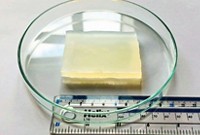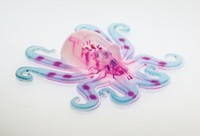Advertisement
Grab your lab coat. Let's get started
Welcome!
Welcome!
Create an account below to get 6 C&EN articles per month, receive newsletters and more - all free.
It seems this is your first time logging in online. Please enter the following information to continue.
As an ACS member you automatically get access to this site. All we need is few more details to create your reading experience.
Not you? Sign in with a different account.
Not you? Sign in with a different account.
ERROR 1
ERROR 1
ERROR 2
ERROR 2
ERROR 2
ERROR 2
ERROR 2
Password and Confirm password must match.
If you have an ACS member number, please enter it here so we can link this account to your membership. (optional)
ERROR 2
ACS values your privacy. By submitting your information, you are gaining access to C&EN and subscribing to our weekly newsletter. We use the information you provide to make your reading experience better, and we will never sell your data to third party members.
Synthesis
Octopus look-alike is first robot that’s self-powered, untethered, and entirely soft
“Octobot” paves the way for a new generation of wearable electronics and biomedical applications
by Sarah Everts
August 30, 2016

A new eight-armed robot’s rhythmic, tentacle-flailing dance routine is so awkwardly cute that you might not immediately grasp the engineering feat achieved by the octopus mimic.
Dubbed the “octobot,” it is the first robot to be self-propelled, untethered, and made entirely from soft materials (Nature 2016, DOI: 10.1030/nature19100). All previous robots have either had some rigid components or they’ve been attached to a rigid system, explains Harvard University’s Jennifer A. Lewis, who, along with colleague Robert J. Wood, led the team that built the machine.
The achievement helps pave the way for soft robots that can perform search-and-rescue operations and exploration or devices that can be put to work as soft endoscopes in biomedical applications, note Barbara Mazzolai and Virgilio Mattoli of the Center for Micro-BioRobotics in an associated commentary (Nature 2016, DOI: 10.1038/536400a). “Robots made from soft, deformable materials would be better able to grasp and manipulate unknown objects, and to move on unstructured and rough terrains, and might be less hazardous to people,” they add.
Lewis and colleagues made the octobot using a combination of 3-D printing, molding, and soft lithography. Hydrogen peroxide fuels the robot: When the chemical, encapsulated within the machine’s core, comes in contact with a platinum catalyst in a reaction chamber, the hydrogen peroxide breaks down into oxygen gas and water vapor that power the robot’s tentacle motions. Microfluidic logic circuits direct this gas into four of the octobot’s arms at a time, moving half the tentacles out and up with pneumatic pressure. The sequence is then repeated with the octobot’s remaining four tentacles so that every other arm of the robot is either up or down at any given time.
This motion “is a very minimalist embodiment of our concept,” Lewis says. “But it’s a sea change for what could be done,” she adds.




Join the conversation
Contact the reporter
Submit a Letter to the Editor for publication
Engage with us on Twitter